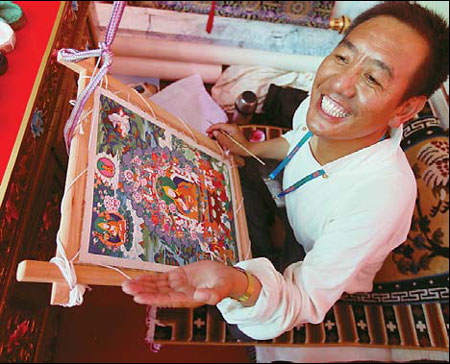Tibetan heritage on display
 |
| A Tibetan woman weaves a wool apron. |
Traditions, art and crafts highlighted during autonomous region's celebrations, Wang Hongyi reports.
With the theme "Heaven in Tibet," the exhibition of Tibet's cultural heritage is undoubtedly the highlight of the Tibet Week, which began on Sept 1 at the Expo 2010 Shanghai, Tibet is a region endowed with a rich ethnic and folk cultural heritage. In its long history, Tibetans have created and inherited a large amount of cultural heritage, which has a great variety and many unique characteristics.
Tibetan heritage is an important and intrinsic part of Chinese culture, and now visitors have a chance to experience Tibetan culture up close.
In the exhibition area of the Baosteel Stage, the art of tangkha steals the limelight during Tibet Week.
Tangkha, a transliteration of a Tibetan word, refers to a kind of painting scroll mounted on dyed brocade.
The distinct ethnic flavor, heady religious aura and unique art style, makes the tangkha a cherished culture tradition among Tibetans. With its main focus on religion, the theme of tangkha covers many fields including history, politics, culture and social customs. It is often seen as an encyclopedia of Tibetan culture and heritage.
The painting process that goes into creating a tangkha is complicated and uses high-quality materials. Tangkha also has strong ethnic characteristics.
"Tangkha has more than 1,000 years of history. Even as time changes, the technique of painting tangkha remains the same," said Tibetan artist, Tenpa Ratang.
Sixty-nine-year-old Tenpa is a professor at the fine art department of the University of Tibet. He began painting tangkha at the age 11.
"People's lives in Tibet have improved greatly during the past decades. Now we have lots of food, even seafood," he said. "All kinds of food can be bought easily at the market."
Visitors can also watch Tibetan apron weaving from craftspeople of Jendashu Town in Lokha Prefecture in Tibet. The wool apron is called a bangden. This town has a history of over 1,000 years in producing wool aprons.
Also on display will be the craft of woodblock carving. Tibetan woodblock carving began in the 14th century. Over the centuries, Tibetan people not only have produced the unique art of woodblock carving, but also created new carving and painting skills. Buddhist scriptures, statues, portraits, natural scenes and various religious patterns are carved on wood blocks.
Also on display during Tibet Week are displays of Tibetan incense, Tibetan gold and silver forging, Tibetan masks, carpet weaving, woodblock printing and traditional Tibetan medicine.
There are also traditional Tibetan foodstuffs on display, including yak butter tea and barley wine, both indispensable drinks in Tibetan people's daily lives.
 |
| A Tibetan artist at work on a tangkha painting at the Baosteel Stage. |
 0
0 







Go to Forum >>0 Comments